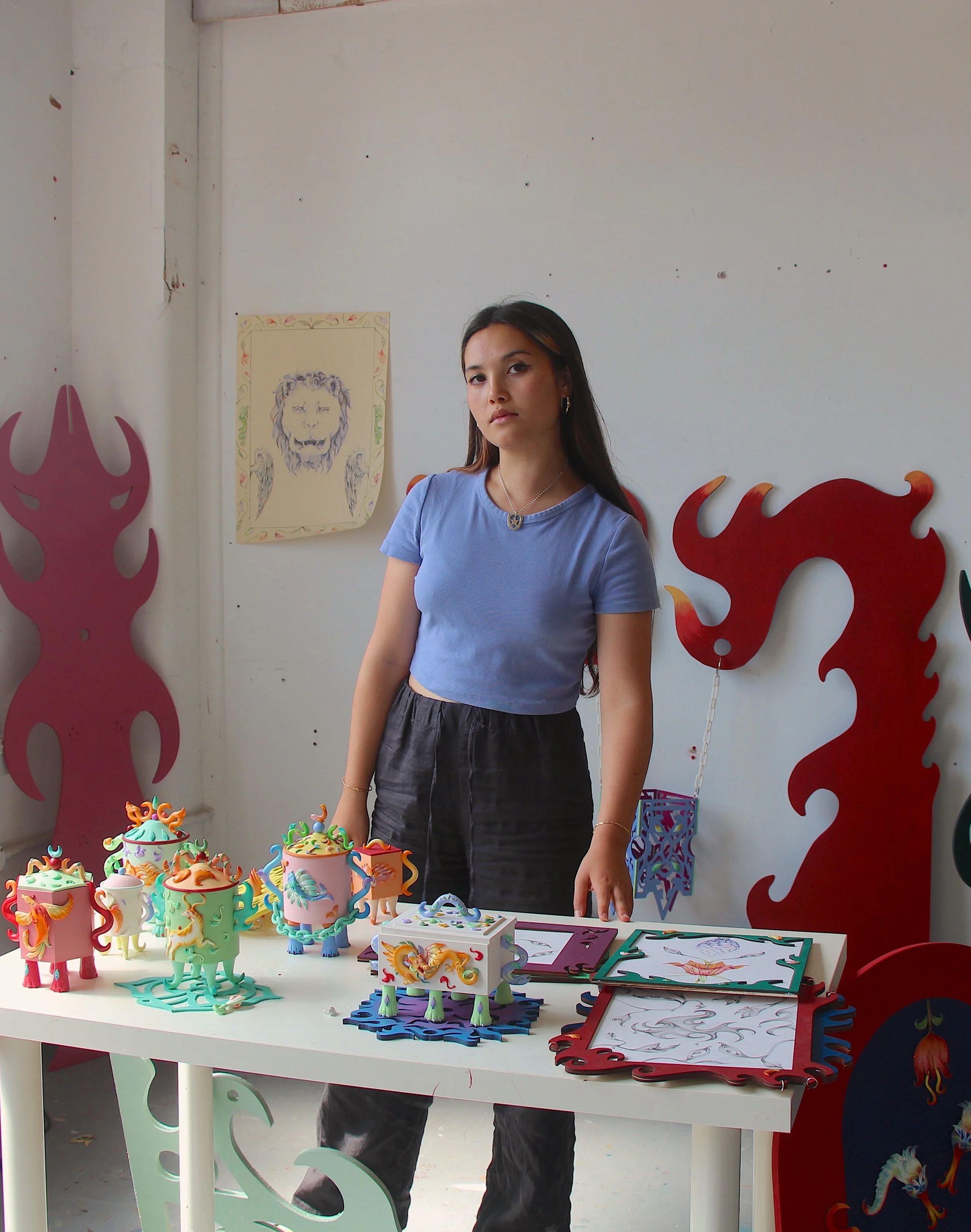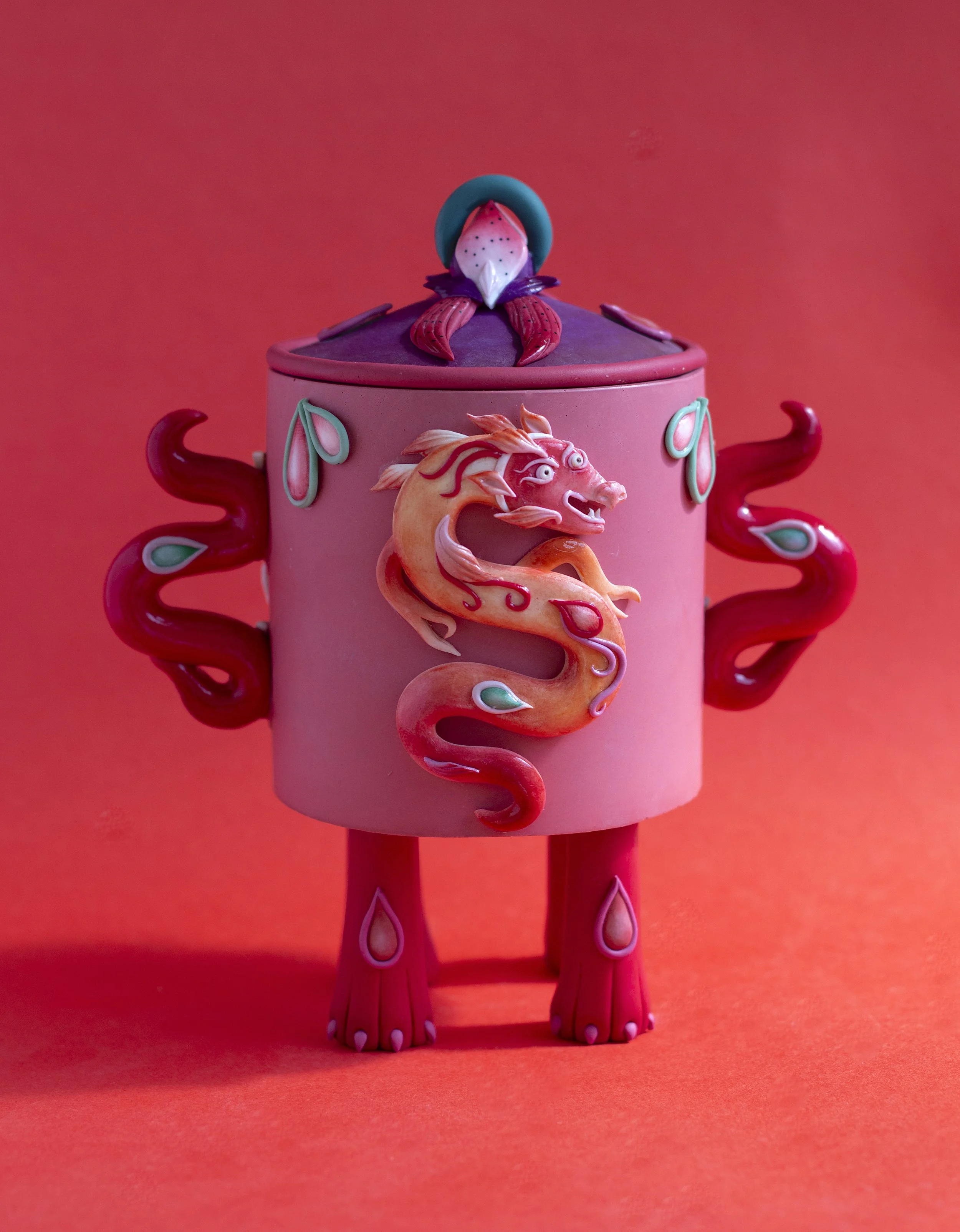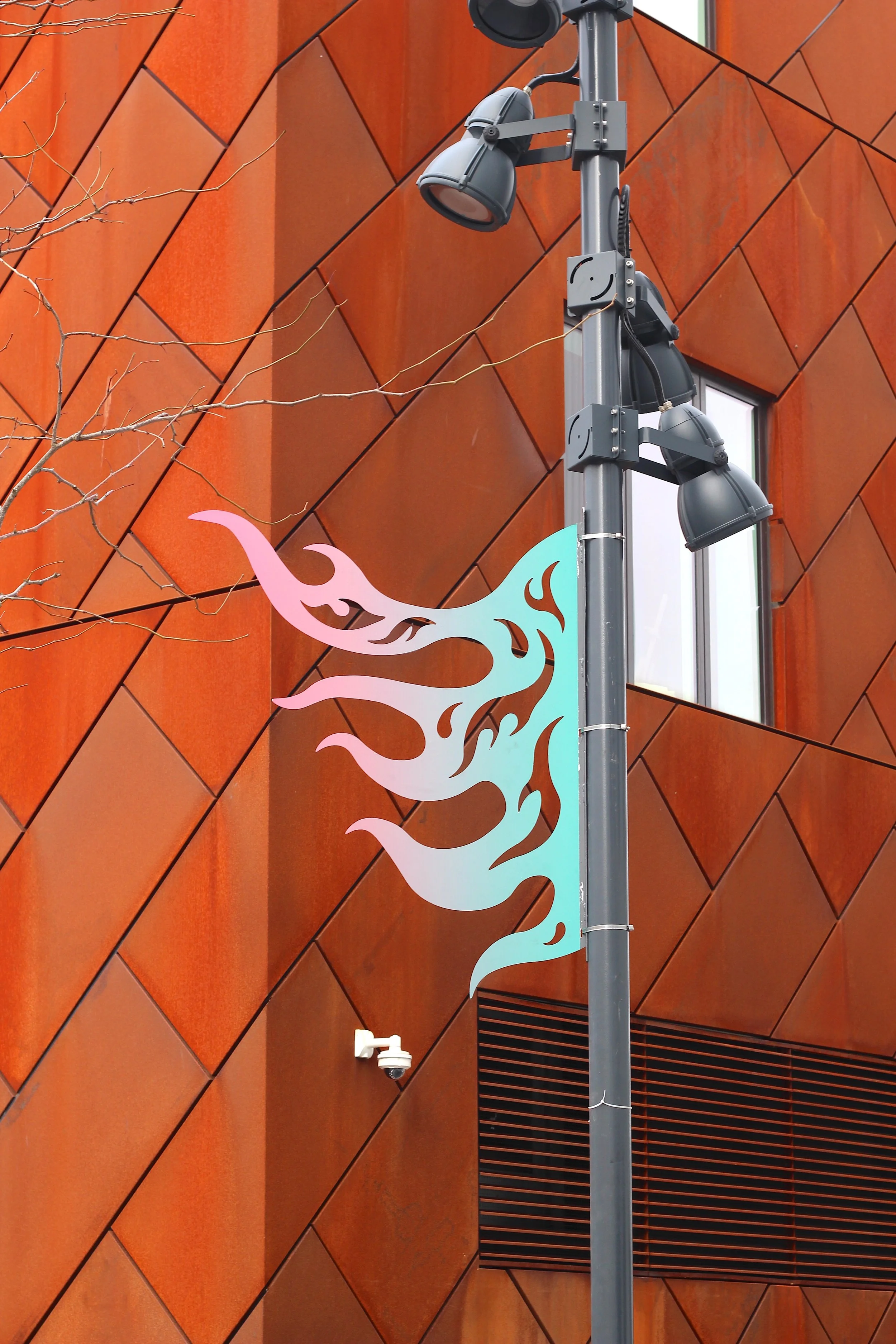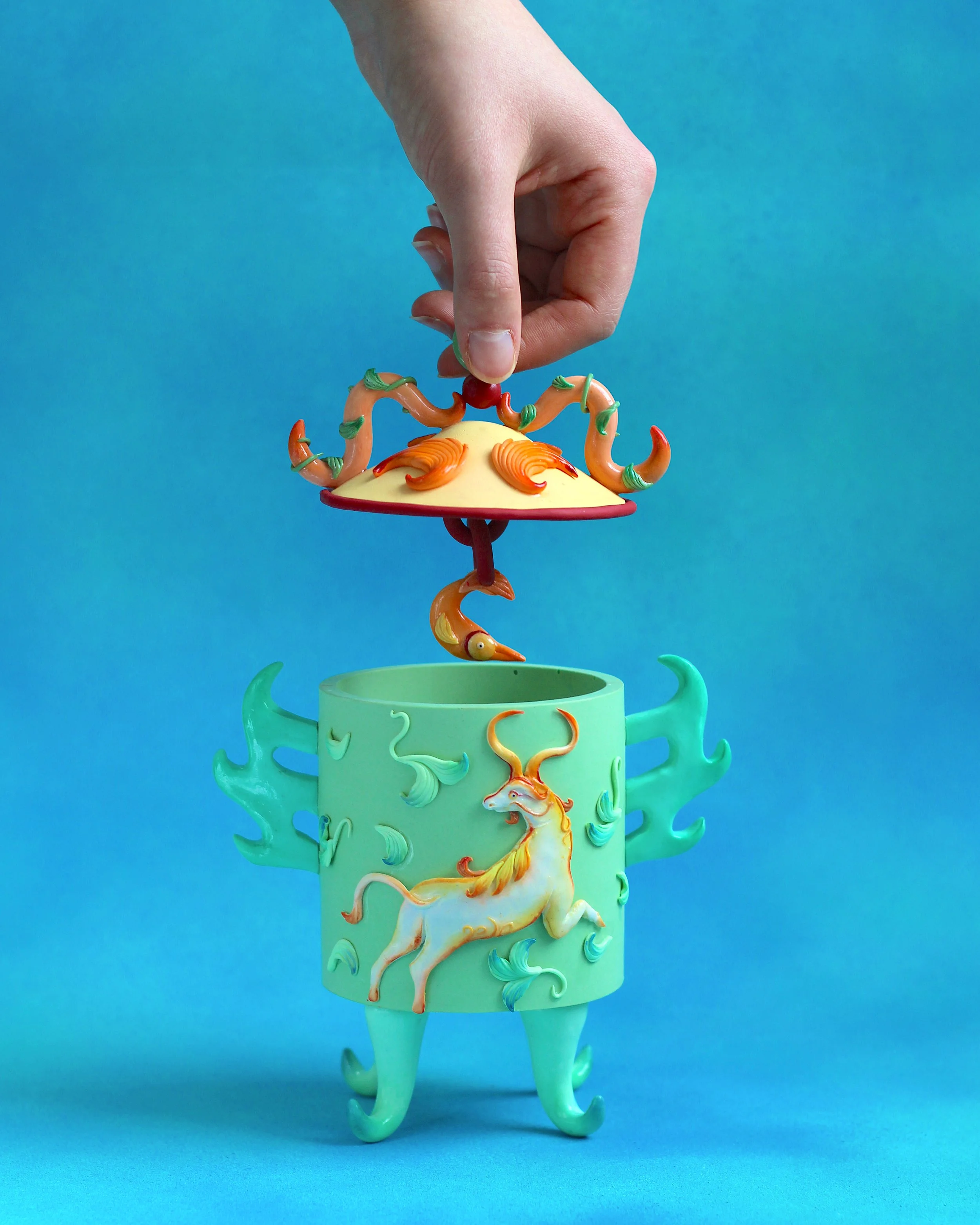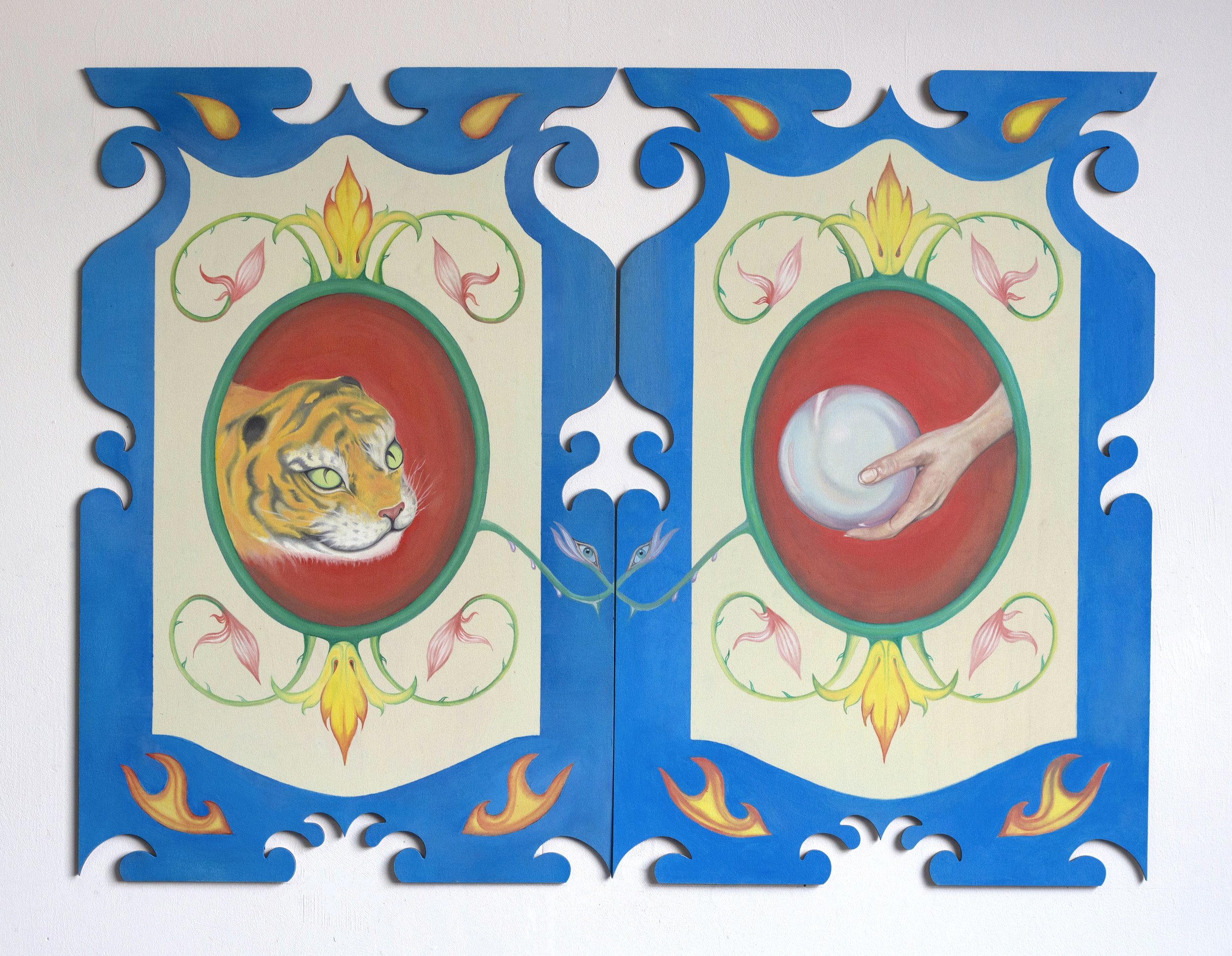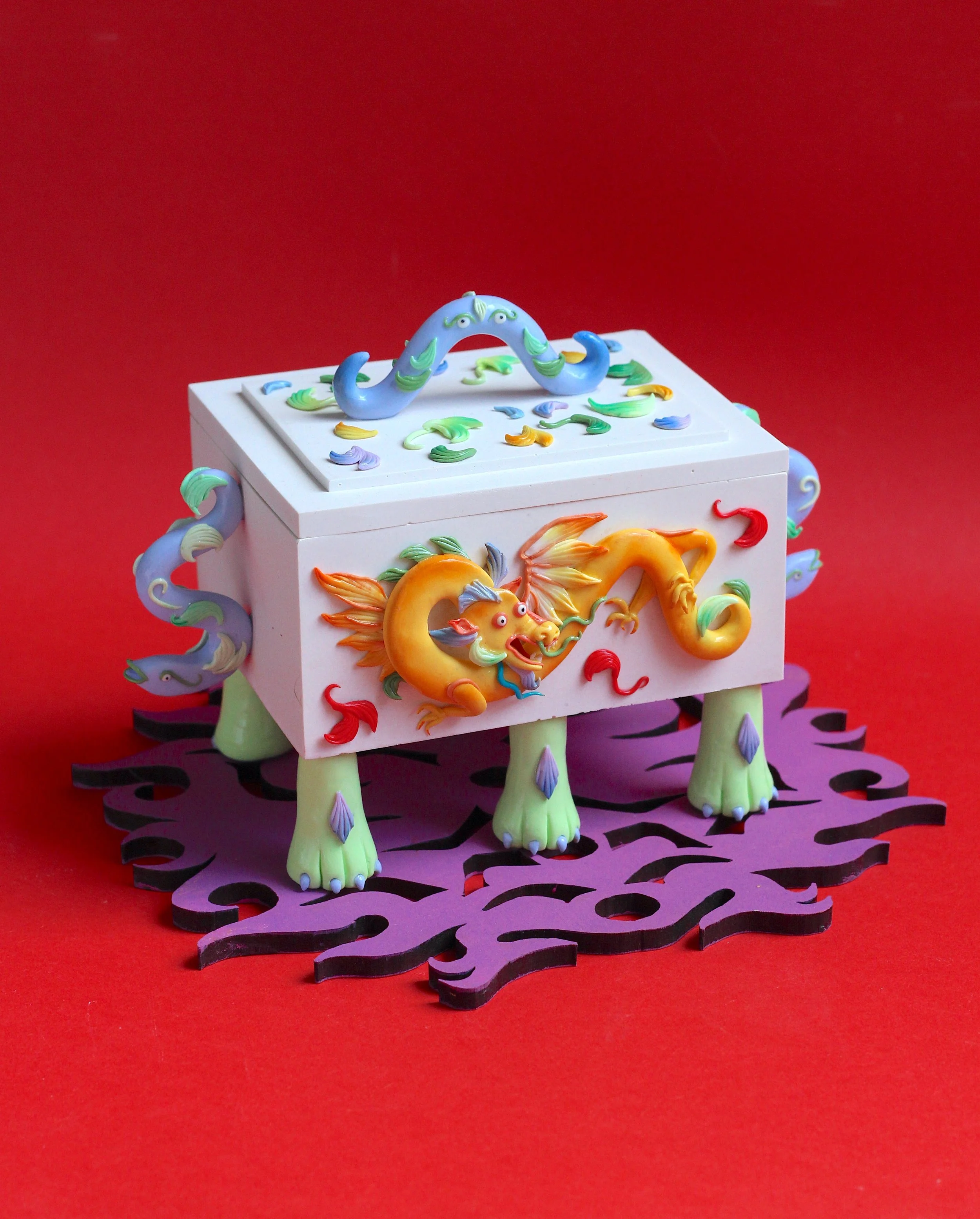Reframing the Canon
Hannah Lim in her studio
Meet rising sculptor Hannah Lim. Her intricate works explore the complex relationship between Eastern and Western cultures. Through playful, furniture-like structures that reference Chinoiserie, Lim reimagines 18th-century aesthetics, breathing life into her cultural exploration✨
Addy: Hannah, thanks so much for joining! Can you tell me about your earliest experience with art?
Hannah: My earliest experience would have been of someone else's art. But I think in terms of making art myself, from a young age, drawing was always something that was really enjoyable. It was something that I actually did with a lot of my friends and it became a sort of fun, trendy thing for us all to do together.
Growing up in London, I was surrounded by art galleries and places like the Tate Modern. All these places were definitely a significant part of my childhood. I'm lucky to have been exposed to so many different types of art, and I think it definitely inspired my creativity from a young age.
Addy: I love that. We’re so lucky to have grown up with free museums around us. That’s so rare.
Hannah: Definitely. I also feel like, growing up there were lots of Turbine Hall commissions and really amazing, groundbreaking projects to go and experience. So yeah, it's a real gift to be so close to all of these amazing museums and shows and to have access to them.
Addy: Definitely. How has your heritage influenced your practice?
Hannah: I grew up in the UK, and most of my experiences have been here, so in lots of ways, I feel very British. My dad is Chinese Singaporean, and so that's also a really important part of my identity. It's really shaped my experiences and the way that people interact with me.
I think I was always interested in exploring this idea of being mixed and the different cultural experiences within my work, but I was never quite sure how to go about doing that in a way that felt appropriate. I was interested in connecting, or reconnecting, with my Chinese Singaporean heritage, but I wanted to do it in a way that felt insightful and personal to me, as someone that is, in a way, not Singaporean, because I haven't grown up there. I visit every few years as someone that is part of that culture, but also not part of that culture. I think that's a big aspect of being mixed. So for a long while, I was trying to figure out how to approach this subject in my work in a way that is exciting and interesting, and feels appropriate to me.
Golden Tiger Snuff Bottle by Hannah Lim
I ended up becoming really interested in this particular design trend called Chinoiserie, which is an 18th century aesthetic style that came about through the colonial period. It sort of happened through European designers appropriating and reimagining Chinese designs for the European market.
At the time that I became interested in that trend, there was a lot of conversation around cultural appropriation, which really interested me. I think Chinoiserie definitely plays into this idea of cultural appropriation, but it's also very intriguing. In a very dramatic, flamboyant, colourful way, this trend represents two cultures that have crossed over at a particular point in time. So I wanted to kind of reimagine this design style in my work, but in a much more appropriate, considered way.
I wanted to also use the practice as a way to reconnect with my own heritage and explore parts of traditional Chinese design and making techniques. My practice kind of evolved from that point. I started making these large furniture-like sculptures that were quite creaturely and flamboyant, and had a lot of symbols and images within them. Then, from that point, my practice has expanded into lots of different areas, like mythology and Ornamentalism. There are lots of different elements that have come into my work, but my heritage is the real starting point for a lot of the work that I make.
Addy: Amazing. Do you feel like you've learned a lot along the way, just from researching these different movements?
Hannah: Yeah, I think I’ve definitely learned a lot. I feel a lot more confident as well, in terms of understanding my identity, and being comfortable in the fact that I'm not necessarily trying to speak for anyone else, I'm representing this important part of my heritage. Amazingly, it does connect and speak to a lot of people that either share similar experiences to me, or don’t but they’re really interested in the roots of my work. So yeah, I definitely think I've learned so much from making this work and from being an artist in general.
Addy: Absolutely, I think your work resonates with many people raised here, especially those whose parents came from abroad. It captures that feeling of connection to your heritage, yet a longing to be more deeply immersed in it.
Hannah: No, definitely. It’s this feeling of belonging, but also not belonging, and people viewing you in a certain way. It's an experience that I think occurs across many, many cultures.
Addy: Totally. Your furniture-like works serve as both ornamental and functional objects. What initially drew you to sculpture as a medium of expression? I feel like that’s a bit less common.
Ghost Orchid Snuff Bottle by Hannah Lim
Hannah: It definitely is. I didn't really think it at the time, but now I realise that sculpture is a difficult thing to pursue and do. Not because I find making three dimensional work necessarily difficult, I think I'm actually quite suited to making physical, three dimensional things. But there's so much to consider, like the kind of materials you're using, their longevity, how everything fits together, how it's going to be transported. It’s a really complicated medium to work in. To survive as an artist doing sculpture is difficult as well.
I did my foundation at CSM and during that time, my tutor suggested and encouraged me to do sculpture. He was a sculpture tutor so that was probably partially why he encouraged me to do it, but I also think I really enjoyed making objects. Before that, during my A levels, I'd always painted and worked two dimensionally. I think that’s partially because you don't get to try out as many things in school. So generally I was always working two dimensionally, though I used to sometimes create small sculptures now and again.
During my foundation, I was encouraged to do sculpture, and then I sort of never looked back. I'm quite like that, once I pick something, and I've decided to do it, I'm all in. But I do really think that sculpture is the thing that suits me. I feel a lot more free and less worried about what I'm making because it feels more authentic to me. When I paint and draw, it often takes me a lot longer to figure out what I'm doing. The process feels a bit more difficult for me, whereas, when I make sculptural work, it all just flows a bit more easily. So that's my journey into sculpture, and I kind of just stuck with it.
Addy: I love how you made this decision and never looked back. You were like, “This is my life now. I'm a sculptor.”
Hannah: Yeah, I think it's quite fun being a female sculptor. I think it's quite cool.
Addy: Honestly, it’s very cool. How do the intricate details of your sculptures contribute to the overall message you're conveying?
Hannah: I suppose I have two parts of my work. Firstly, there’s the snuff bottles, which in themselves are these very delicate, intricate objects. They’re related to traditional Chinese snuff bottles that you often find when you go to places like the British Museum. Often traditional snuff bottles have designs on them that would have been very personal to their owners, and certain symbols denote particular philosophies or ideas. And so my own snuff bottles, which are inspired by these tiny little objects, are much larger, but they're still very intricate sculptures that are extremely detailed and ornate.
Originally, a lot of the designs were inspired by objects that I had in my home that reminded me of my Singaporean heritage. Then over time, and more recently, they've come to reflect different parts of my research. At the moment, a lot of the snuff bottles that I'm making are inspired by Chinese mythology, and this particular Chinese bestiary known as The Classic of Mountains and Seas. All of the details on my recent snuff bottles are depictions of little creatures from the illustrations in these books. Everything is very intentional.
On the other hand, some details are more spontaneous. I’ve always been quite interested in ornamentation within my work, and more recently, I’ve started researching the critique of ornament during the modernist era. Back then, architects often rejected it for various reasons: some deemed it too feminine or frivolous. Ornament was often also tied to particular cultures that weren’t considered as modern and forward thinking as European cultures, which is another very interesting aspect. The disregarding of cultures that cherished ornament overlooks the rich cultural meaning often embedded within ornamentation.
So I've always been very interested in embracing a maximalist approach in the way that I make work, embracing colour, embracing ornament, and embracing all these details, because they have so much cultural meaning.
Addy: So true. A lot of aesthetic trends and mediums, like textiles, are dismissed due to their cultural associations. These materials and ideas are often disregarded as lesser forms of art simply because of the people traditionally associated with them. So I love the idea of leaning into that and embracing it. Can you describe your creative process?
Hannah: It kind of depends on the work that I'm making. If I'm working on something that's quite large scale and sculptural, then there has to be a lot more planning. Often these types of works are created from drawings. A lot of the work that I create that is larger scale is laser cut, so it has to go through more of a design process and has to be quite precise. The pieces slot together, they're kind of flat packable. All of the joints and slots have to be perfectly measured, so that part of my process is much more structured.
Ruby Dragon Snuff Bottle by Hannah Lim
When I’m making snuff bottles, I'm actually very free and spontaneous in my process. I usually have an idea in my mind of a particular creature or story that I want to focus on, I don't really ever draw them. Usually, I'll start by making that and then I might leave the snuff bottle for a few days, or a week, and come back to it and work on it again. Other times, I have a really clear idea from start to finish and I just make it in one go. Most of the time, I have an idea of a particular motif that I want to put on the piece, or a particular style. It might be that I really want to make a deep red snuff bottle with a creature on it that’s connected to a particular story. Then I add to it as time goes on.
I think with my drawings and paintings, I work in a similar kind of way. They're a little bit more planned than the snuff bottles, but not as planned as the big sculptures. There are lots of different kinds of ways of working depending on the type of work I'm making.
Addy: Do you have a preference?
Hannah: I think making the snuff bottles, particularly if I have a really exciting idea for one, is probably one of my favourite processes because it's just quite enjoyable. They're very intricate and timely to make, but they don't feel as physically taxing as making a big wooden sculpture that I've got to sand, paint, and lacquer. I do also enjoy making the large scale works as well, particularly when I get to collaborate and work other people.
Greenwich Peninsula, Lunar New Year
I recently did a commission with Greenwich Peninsula for Lunar New Year. I designed all of those works, but they were produced elsewhere by another company, so that process was quite nice. It was really great to be working with new materials and working with people that knew how to use these materials and adapt them to the work that I was designing. In terms of the larger sculptures, often I make those in collaboration with other people or for very specific projects. So often that process can be quite exciting and new. I get to try out lots of different things when I'm making those kinds of works. But I think day to day, making the snuff bottles is enjoyable. I like doing them.
Addy: Yes, that project looked amazing across all of the different lampposts. A lot of your works possess a sense of playfulness, what do you hope to communicate?
Hannah: My work often carries significant cultural meaning. It can touch on cultural issues that I think are really important. But at the same time, I also want this lightness and playfulness to be a part of it. I think that playfulness really interests people and draws them in. It gets them to engage with the work, to read into it, and that's when those deeper cultural meanings are revealed.
The playful and colourful aspects definitely make the work more approachable. There are these quirky features that pique people’s interest. Art can be serious, of course, but it can also be playful, interesting, intriguing, and exciting. I like having a balance of all of those elements within my work.
Install shot - In The Margins (solo show 2022)
Addy: Absolutely, I love how it pulls people in, revealing the deeper themes you explore without feeling too intimidating, which is really nice.
Hannah: I totally agree. I hope the playful quality makes my work feel more accessible to people. The details and peculiar aspects give people things to look at and focus on and talk about. So people tend to feel more comfortable discussing them and interacting with them.
Addy: Who and what are your greatest influences?
Hannah: As we spoke about before, my heritage is a big influence in my work. It's been the thing that has pushed me into doing so much research. I've also always been very interested in furniture design, I think that's how I got started in making the particular type of sculptures that I make. That’s also how I ended up looking into Chinoiserie, having this interest in furniture and design, and the way that furniture is documented. I looked through a lot of furniture books and French design books during my degree, and that has really informed the way that a lot of my work looks now. There is this real crossover in my work between art and design, and I really like that. It’s an important influence in my work.
Addy: Are there any particular artists or designers that have stood out to you?
Hannah: Yes, an artist that I actually used to work for a while ago when I was still doing my degree, Tai Shani. I saw her work during Glasgow International, it was an installation at Tramway, which is a gallery in Glasgow, and it was just a really amazing piece. I learned so much from Tai about working across lots of mediums and really embracing different techniques. Her work encompasses performance, painting, sculpture, and installation, and there are so many different parts to her work. It's this blend of strong political messages with beautiful storytelling. I think that’s something that I want to also capture in my own practice. Of course her work is visually amazing as well. I want my work to be visually exciting and to touch upon important issues, whilst also having it feel intriguing and beautiful. She's definitely inspired the way that I work.
Addy: I like that your practice embodies the essence of what you just described.
Hannah: Thank you.
Addy: What role do the materials you work with play in your practice?
Hannah: So for the snuff bottles, they're quite interesting works because I often describe them as being ceramics, but they aren't made with traditional clay, they're actually made from a mixture of materials. The base structure of them is made from Jesmonite, which is similar to plaster, it's really strong. Then all the details are layered. The arms, the legs, and every other detail, is made from polymer clay. It's a really great, versatile material to use. But it's also quite a playful material, it's very colourful, and it comes in these coloured blocks that you can mix together to create different colour tones.
Tate Women’s History Month Commission by Hannah Lim
There's something quite interesting about using this particular material to make works that look almost like porcelain. I use blocks to varnish these works, there's this contrast between the powdery, matte surface of the Jesmonite, and the really glossy finish of the clay. I use chalk as well to create these blends in colour. The whole process and all the materials combined together have developed through lots of experimentation.
Shards of Fire by Hannah Lim
Then with the larger works, I started working in wood because I was basically creating these works that sort of slot together, and primarily using a laser cutter. So for that, wood is the best material to work with. Obviously, it's not super lightweight, but it's lighter than a lot of other sculptural materials. Also, a lot of traditional Chinese furniture was often made from wood and lacquered. So a lot of the larger works that I make, and also the shelves that I make for myself, are lacquered with this shiny gloss that kind of adds to the ornate elements of the pieces.
My preference in terms of painting is to paint with watercolours. These paintings are very intricate, and they feel quite related to the snuff bottles in the way that they are painted and made. Often a lot of these paintings are framed within wooden, slot together frames that are very reminiscent of my sculptural work. So there's a lot of crossover between all the different parts of my practice. Even when I'm working two dimensionally, there are a lot of three dimensional elements that come into the paintings.
Tyger Tyger by Hannah Lim
For the past two years, I’ve been doing a residency with Pangolin, which is a gallery in Kings Cross that specialises in sculpture. They're connected to Pangolin, the foundry, which is in Stroud. So for the past year, I've been making a new series of work, which will come out in the summer, that's all in bronze. Occasionally, I do some sculpture work in metal, but it kind of just depends on the project. I often make a lot of hanging sculptures, and for those, I can’t really make them from metal because it would be way too heavy to hang. Works with pieces that have to be hung are always made from wood.
At the moment, I'm making these new pieces that are cast in bronze, and some parts of the works are also plasma cut in steel. Plasma cutting is a very similar process to laser cutting, in that you create a drawing, and then a laser will cut into the material to create the shapes. So yeah, there are a few different materials that I work with.
Addy: The materials that you use are very connected to each other, and that feels very intentional. I'm excited to see the bronze works!
Hannah: They're almost finished now, I’m really excited. It's nice to be working with a new medium.
Addy: Yeah, it also sounds like it’s quite interesting to try different materials that you don’t usually work with day to day.
Hannah: Absolutely. Particularly because working in a larger scale is such an expensive process. I've been lucky that I have this grant with the residency to create this new body of work. Without opportunities like this, you actually don't get to learn how to do it. Pangolin’s amazing because it has multiple workshops and loads of people working there creating huge pieces. It's really amazing to see all the steps and processes. So yeah, a very cool opportunity.
Addy: It's a great gallery, I've been there a few times. The shows are always very interesting. How has your practice evolved over time?
Hannah: I suppose my research has broadened quite a lot. Most of the research I do connects back to this beginning point of cultural identity. Also, in the last two years, I've started painting again. Up until that point, I was very much only doing sculpture. During my degree, I was very much just making sculptures that were larger scale. Then I had this idea that I wanted to start working on smaller, intricate sculptures that would inhabit these installations that I was making.
Many of my earlier sculptures were large, powerful installations assembled from various components. However, I wanted to also incorporate intriguing smaller objects that would draw people in. This is partly how the snuff bottles came about. I graduated in lockdown and so I didn't have a degree show. Being at home meant that I ended up focusing on making these little sculptures.
Install shot - Ornamental Mythologies (solo show 2022)
I think it's funny because a lot of people start from making much smaller, intricate works, and then they go bigger and bigger and bigger. Whereas for me, I've kind of gone from like, big, then really tiny, a bit bigger, then changing to painting. Now that I have more opportunities to make big works, I'm starting to make them again. That's another thing with sculpture, once you graduate, it's so hard to find all the workshops and places where you can actually make large scale work. It's also expensive to make bigger works. So you have to have a practice, or have parts of your practice, that are, I suppose, a bit more commercial. Then that allows you to have other parts of your practice where you can be a lot more experimental. Luckily, I'm at a point now where I'm able to do these projects that help me to keep creating the more large scale works.
Addy: It’s so interesting that you sort of did the reverse, going from bigger works to smaller works.
Hannah: Yeah, and it's nice to be able to make these big things and then also change over to making these really intricate small, detailed pieces as well.
Addy: I think it keeps things interesting. You'll never get bored.
Hannah: Definitely.
Addy: How important are the titles of your works?
Hannah: They're important, but I don't overthink them too much. Once I’ve picked a title and I think that it sounds good, I go forward with it. With the snuff bottles, a lot of the names of the pieces are inspired by a particular motif. At the moment, a lot of those motifs come from a particular Chinese bestiary that I've been reading into a lot. All of the creatures in this book have specific names, so if I depict a creature on the piece, the name is often inspired by that particular creature.
Box of Beasts by Hannah Lim
With my larger sculptures, I have a sort of obsession with fire and flames so quite a lot of those pieces have fiery titles. With my paintings, particularly with the pieces that depict particular creatures, sometimes the title might be from a story involving those creatures. Overall, my titles are quite literal and relate to what I can see within the work, and the kind of motifs I can see within the pieces. So yeah, they're important. I like it when the title of the piece is quite fun, I think.
Addy: Leaning back into that playfulness aspect.
Hannah: Exactly.
Addy: So at the end of interviews, I always do something called a rapid fire round 🔥 Art Deco or Art Nouveau?
Hannah: I'm probably gonna regret whatever I pick. Art Nouveau.
Addy: Sculpture or installation?
Hannah: Oh, gosh. Okay, I'm gonna say sculpture.
Addy: Modern or classic?
Hannah: Oh, this is tricky. I'm gonna say classic just because a lot of stuff that I'm looking into at the moment feels more historical. I'm looking at lots of old pictures and images and objects. So I’ll say classic.
Addy: Satin or silk?
Hannah: Silk.
Addy: Fiction or nonfiction?
Hannah: Fiction.
Addy: Same! I love fiction. Sunflowers or roses?
Hannah: Roses.
Addy: Summer or winter?
Hannah: I think summer.
Addy: Introvert or extrovert?
Hannah: Introvert, I am an introvert.
Addy: Indie or pop?
Hannah: Pop.
Addy: Saturday night or Sunday morning?
Hannah: Sunday morning.
Addy: Final one, what was the last song that you listened to?
Hannah: I think it was Caroline Polachek Spring Is Coming With A Strawberry In The Mouth. It's a very long name, but it's a really good song. Very like summer/spring vibes.
Addy: Omg, I’m such a big fan. I don’t know if you can see her vinyls behind me.
Hannah: Yes, the album covers are so good.
Addy: Her music is amazing, I’m obsessed.
Hannah: Yeah, so we have that in common.
Addy: Love that for us. Hannah, thank you so much for taking the time to answer all of my questions!
For more from Hannah, check out her latest projects here!

